New Heuristic Algorithm for Low Energy Mapping for 2.5-D Integration
Abstract
:1. Introduction
2. Model Establishment
2.1. The 2.5-D IC Integration Mapping Model
2.2. Communication Energy Consumption Model
3. Mapping Algorithm Description
| Algorithm 1 The pseudo-code of chiplet communication energy consumption optimal algorithm |
| Input: a chiplet size table. a chiplet communication graph. a topology graph. Output: a mapping result mapbest with best energy consumption. |
| 1. Obtain CPL by priority_generate(G); 2. Initial chiplet i = first chiplet in CPL; 3. Initial node set ITS = initialnode_generate(M); 4. Communication energy consumption CECmin = +∞; 5. For (k = 1; k ≤ |ITS|; k++) { 6. Gmapped = ∅; Gummaped = G; Tunmapped = T; 7. mapk(ci) = tk; Tunmapped = Tunmapped − {tk};//tk ∈ITS 8. Gmapped = Gmapped +{ci}; Gunmapped = Gunmapped − {ci}; 9. While (Gunmapped ≠ ∅) { 10. Next selection chiplet cj = next_priority (Gunmapped,Gmapped); 11. Next selection node tn = next_node (Tunmapped); 12. mapk(cj) = tn; Tunmapped = Tunmapped − {tn}; 13. Gmapped = Gmapped +{cj}; Gunmapped = Gunmapped − {cj};} 14. CECk = calculate_cec (mapk ( )); 15. If (CECk < CECmin) { 16. CECmin = CECk; mapbest = mapk ( );}} 17. Return mapbest ( ); |
3.1. The Priority_Generate Function
3.2. The Initialnode_Generate Function
3.3. The Next_Chiplet Function
| Algorithm 2 The next_chiplet function |
| Input: chiplet priority list, CPL. a chiplet mapping flag matrix, G(k). a chiplet communication matrix, cost(k1) (k2). Output: the next chiplet tk. |
| 1. For (k1 = 0; k1 < N; k1++) { 2. tcost = 0, tmax = 0; 3. If (G[k1] != −2){ 4. For (k2 = 0; k2 < N; k2++){ 5. If (G[k2] == −2 && cost[k1] [k2] > 0) 6. tcost = tcost + cost[k1] [k2];} 7. If (tcost > tmax){ 8. tmax = tcost; 9. tk = k1;}}} 10. Return tk; |
3.4. The Next_Node Function
| Algorithm 3 Secondary local exploration algorithm |
| Input: the CEC of the chiplet to be mapped, tcost. a chiplet mapping flag matrix, G(k). a chiplet communication matrix, cost(k1) (k2). Output: The next chiplet tk. |
| 1. tmin = 0, tmax = 0, tp = 0; 2. If (tcost < tmin) { 3. tmin = tcost 4. tp = k1;} 5. Else if (tcost = tmin){ 6. For (k1 = 0; k1 < N; k1++) { 7. tcost = 0; 8. If (G[k1] != −2) { 9. For (k2 = 0; k2 < N; k2++) { 10. If (G[k2] == −2 && cost[k1] [k2] > 0) 11. tcost = tcost + cost[k1] [k2]; } 12. If (tcost > tmax || (tcost == tmax && 13. DG[k3] > DG[tk2])) { 14. tmax = tcost; 15. tk2 = k1; 16. tcost = 0;}}} 17. Return tk2; |
4. Experiment Results
5. Conclusions
Author Contributions
Funding
Conflicts of Interest
References
- Moore, G.E. Cramming More Components Onto Integrated Circuits. Proc. IEEE 2002, 86, 82–85. [Google Scholar] [CrossRef]
- Kabir, M.A.; Peng, Y. Holistic Chiplet–Package Co-Optimization for Agile Custom 2.5-D Design. IEEE Trans. Compon. Packag. Manuf. Technol. 2021, 11, 715–726. [Google Scholar] [CrossRef]
- Lim, S.P.S.; Chidambaram, V.; Jaafar, N.; Seit, W. Development of 2.5 D high density device on large ultra-thin active interposer. In Proceedings of the 2019 IEEE 21st Electronics Packaging Technology Conference (EPTC), Singapore, 4–6 December 2019. [Google Scholar]
- Chaware, R.; Nagarajan, K.; Ramalingam, S. Assembly and reliability challenges in 3D integration of 28nm FPGA die on a large high density 65nm passive interposer. In Proceedings of the Electronic Components & Technology Conference, San Diego, CA, USA, 29 May–1 June 2012. [Google Scholar]
- Coskun, A.; Eris, F.; Joshi, A.; Kahng, A.B.; Ma, Y.; Narayan, A.; Srinivas, V. Cross-layer co-optimization of network design and chiplet placement in 2.5-D systems. IEEE Trans. Comput.-Aided Des. Integr. Circuits Syst. 2020, 39, 5183–5196. [Google Scholar] [CrossRef]
- Kim, J.; Murali, G.; Park, H.; Qin, E.; Kwon, H.; Chekuri, V.C.K.; Rahman, N.M.; Dasari, N.; Singh, A.; Lee, M.; et al. Architecture, Chip, and Package Codesign Flow for Interposer-Based 2.5-D Chiplet Integration Enabling Heterogeneous IP Reuse. IEEE Trans. Very Large Scale Integr. (VLSI) Syst. 2020, 28, 2424–2437. [Google Scholar] [CrossRef]
- Kim, J.; Chekuri, V.C.K.; Rahman, N.M.; Dolatsara, M.A.; Torun, H.; Swaminathan, M.; Mukhopadhyay, S.; Lim, S.K. Silicon vs. Organic Interposer: PPA and Reliability Tradeoffs in Heterogeneous 2.5 D Chiplet Integration. In Proceedings of the 2020 IEEE 38th International Conference on Computer Design (ICCD), Hartford, CT, USA, 18–21 October 2020. [Google Scholar]
- Li, T.; Hou, J.; Yan, J.; Liu, R.; Yang, H.; Sun, Z. Chiplet heterogeneous integration technology—Status and challenges. Electronics 2020, 9, 670. [Google Scholar] [CrossRef] [Green Version]
- Lau, J.H. Recent advances and trends in advanced packaging. IEEE Trans. Compon. Packag. Manuf. Technol. 2022, 12, 228–252. [Google Scholar] [CrossRef]
- Kim, J.; Chekuri, V.C.K.; Rahman, N.M.; Dolatsara, M.A.; Torun, H.M.; Swaminathan, M.; Mukhopadhyay, S.; Lim, S.K. Chiplet/Interposer Co-Design for Power Delivery Network Optimization in Heterogeneous 2.5-D ICs. IEEE Trans. Compon. Packag. Manuf. Technol. 2021, 11, 2148–2157. [Google Scholar] [CrossRef]
- Kabir, M.A.; Peng, Y. Chiplet-package co-design for 2.5 D systems using standard ASIC CAD tools. In Proceedings of the 2020 25th Asia and South Pacific Design Automation Conference (ASP-DAC), Beijing, China, 13–16 January 2020. [Google Scholar]
- Park, H.; Kim, J.; Chekuri, V.C.K.; Dolatsara, M.A.; Nabeel, M.; Bojesomo, A.; Patnaik, S.; Sinanoglu, O.; Swaminathan, M.; Mukhopadhyay, S.; et al. Design Flow for Active Interposer-Based 2.5-D ICs and Study of RISC-V Architecture With Secure NoC. IEEE Trans. Compon. Packag. Manuf. Technol. 2020, 10, 2047–2060. [Google Scholar] [CrossRef]
- Murali, S.; De Micheli, G. Bandwidth-constrained mapping of cores onto NoC architectures. In Proceedings of the Design, Automation and Test in Europe Conference and Exhibition, Paris, France, 16–20 February 2004. [Google Scholar]
- Wang, X.; Choi, T.M.; Yue, X.; Zhang, M.; Du, W. An effective optimization algorithm for application mapping in network-on-chip designs. IEEE Trans. Ind. Electron. 2019, 67, 5798–5809. [Google Scholar] [CrossRef]
- Liu, Y.; Ruan, Y.; Lai, Z.; Jing, W. Energy and thermal aware mapping for mesh-based NoC architectures using multi-objective ant colony algorithm. In Proceedings of the 2011 3rd International Conference on Computer Research and Development, Shanghai, China, 11–13 March 2011. [Google Scholar]
- Liu, Y.; Ruan, Y.; Lai, Z. New heuristic algorithms for low-energy mapping and routing in 3D NoC. Int. J. Comput. Appl. Technol. 2013, 47, 1–13. [Google Scholar] [CrossRef]
- Ye, T.T.; Micheli, G.D.; Benini, L. Analysis of power consumption on switch fabrics in network routers. In Proceedings of the 39th Annual Design Automation Conference, New Orleans, LO, USA, 10–14 June 2002. [Google Scholar]
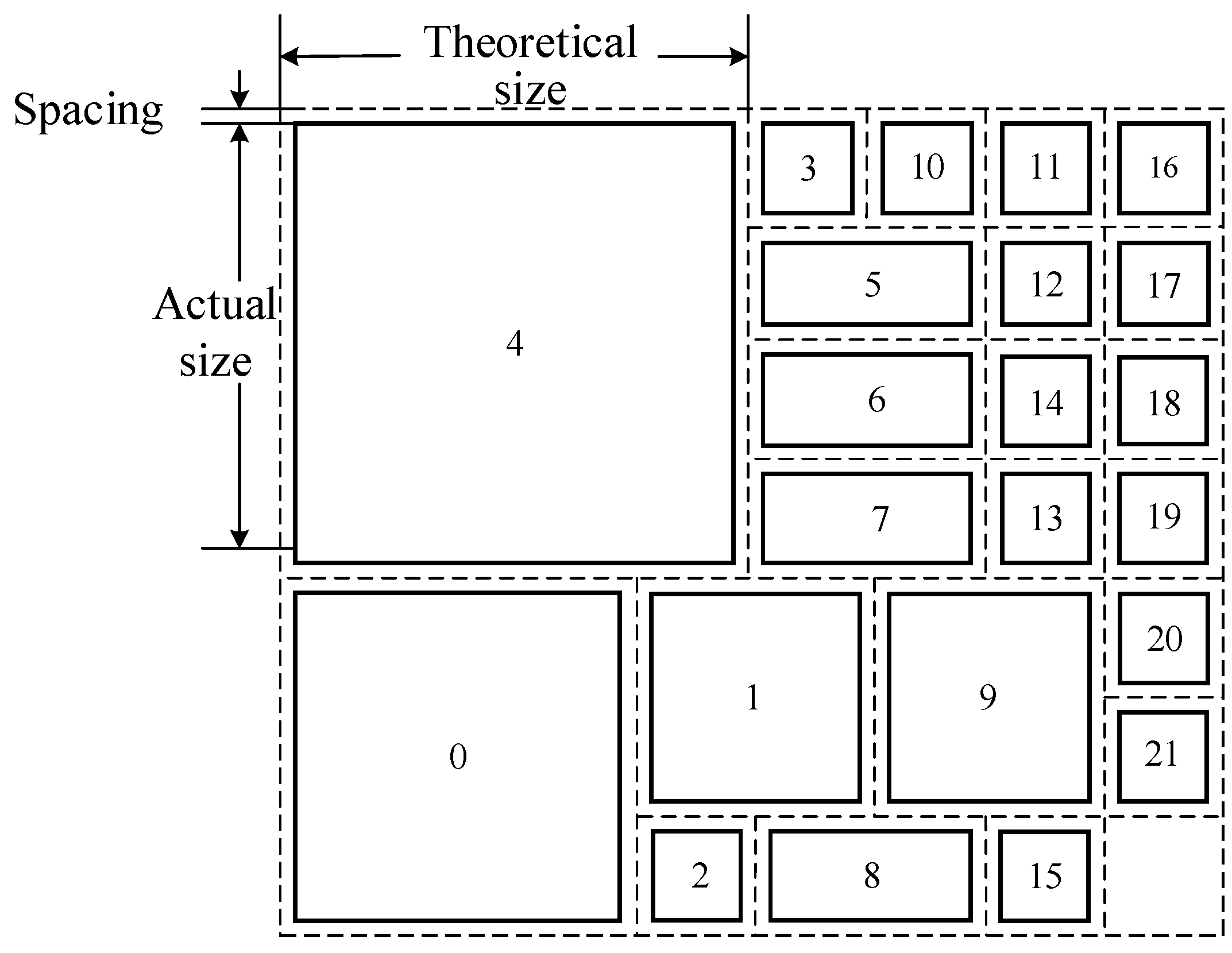

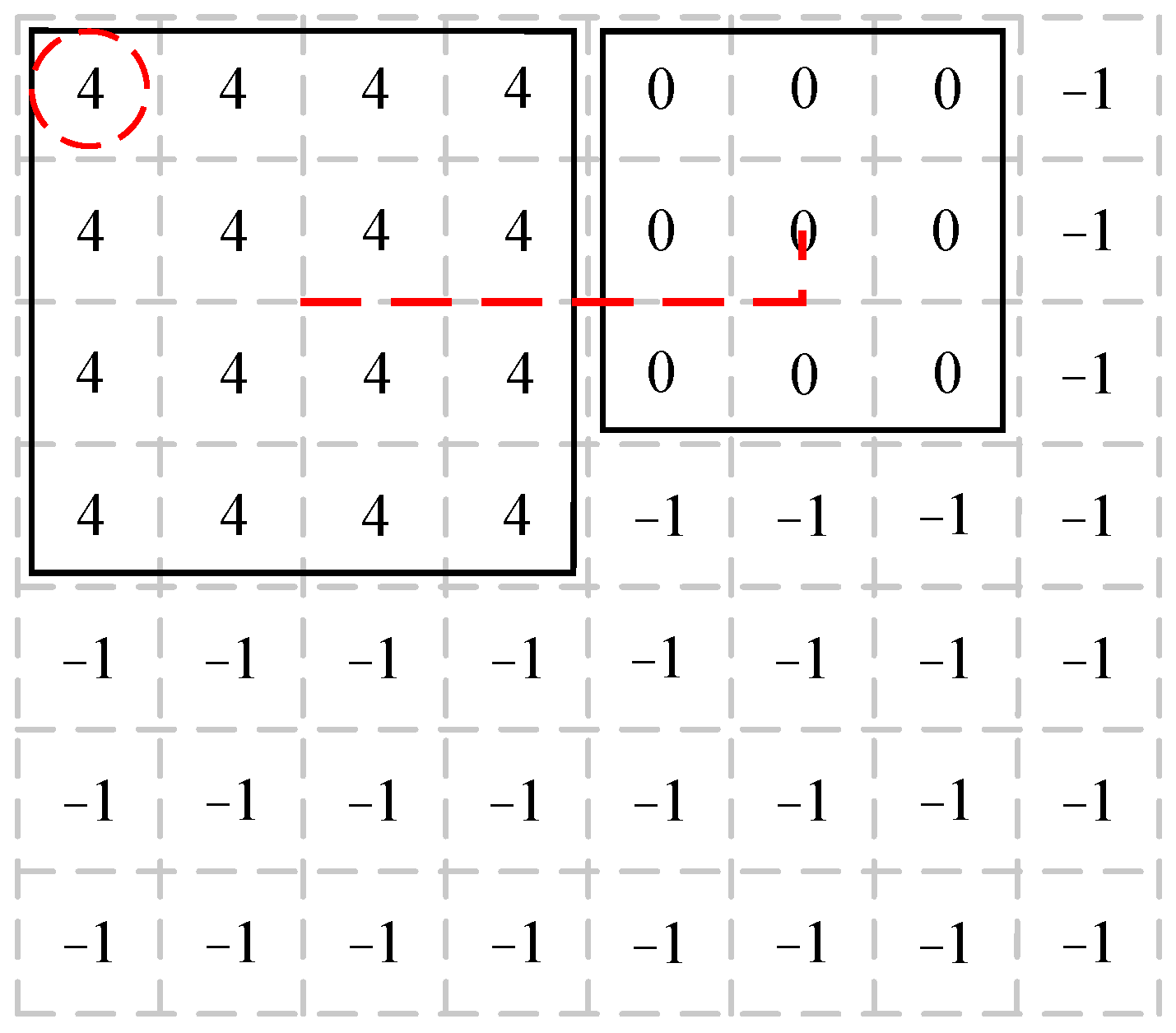

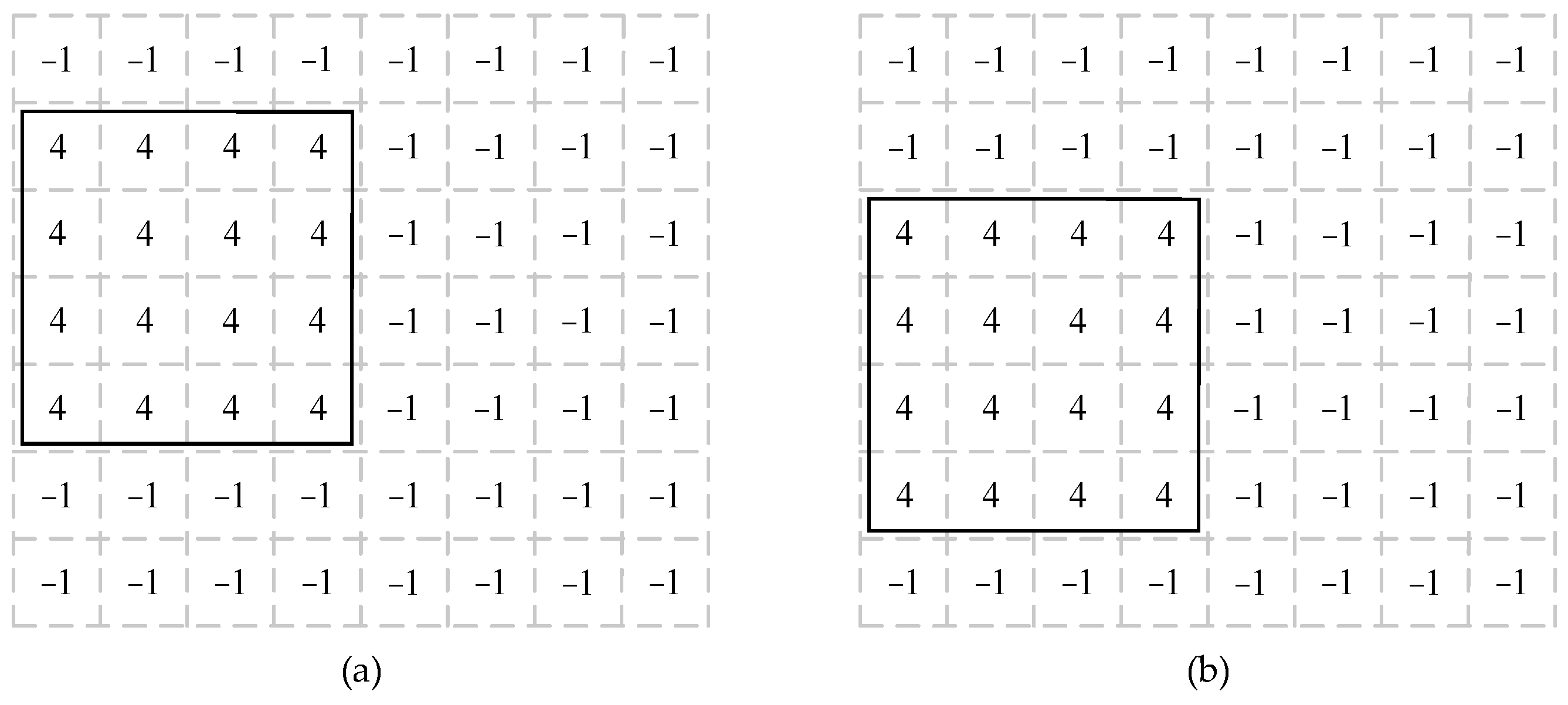
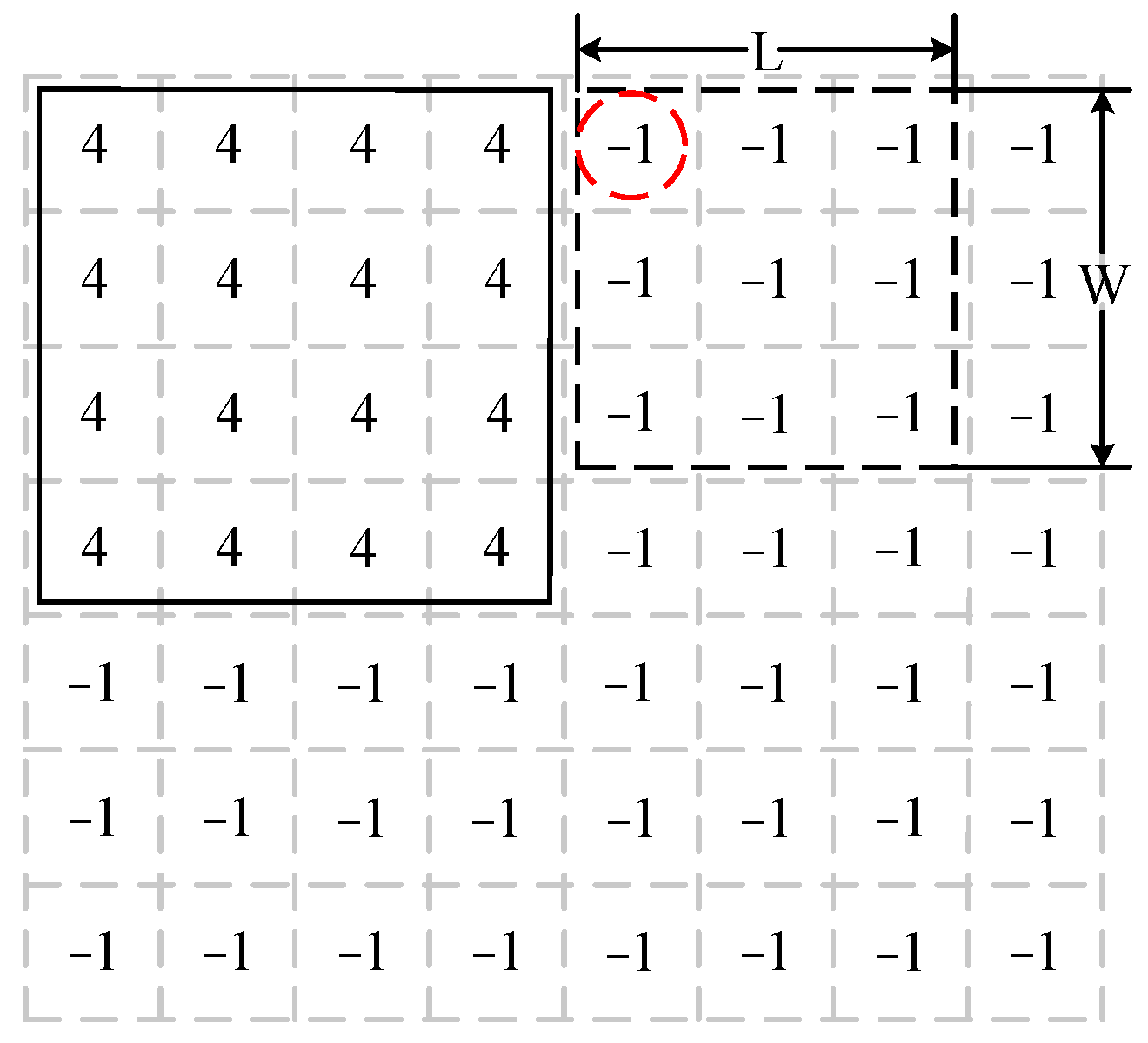

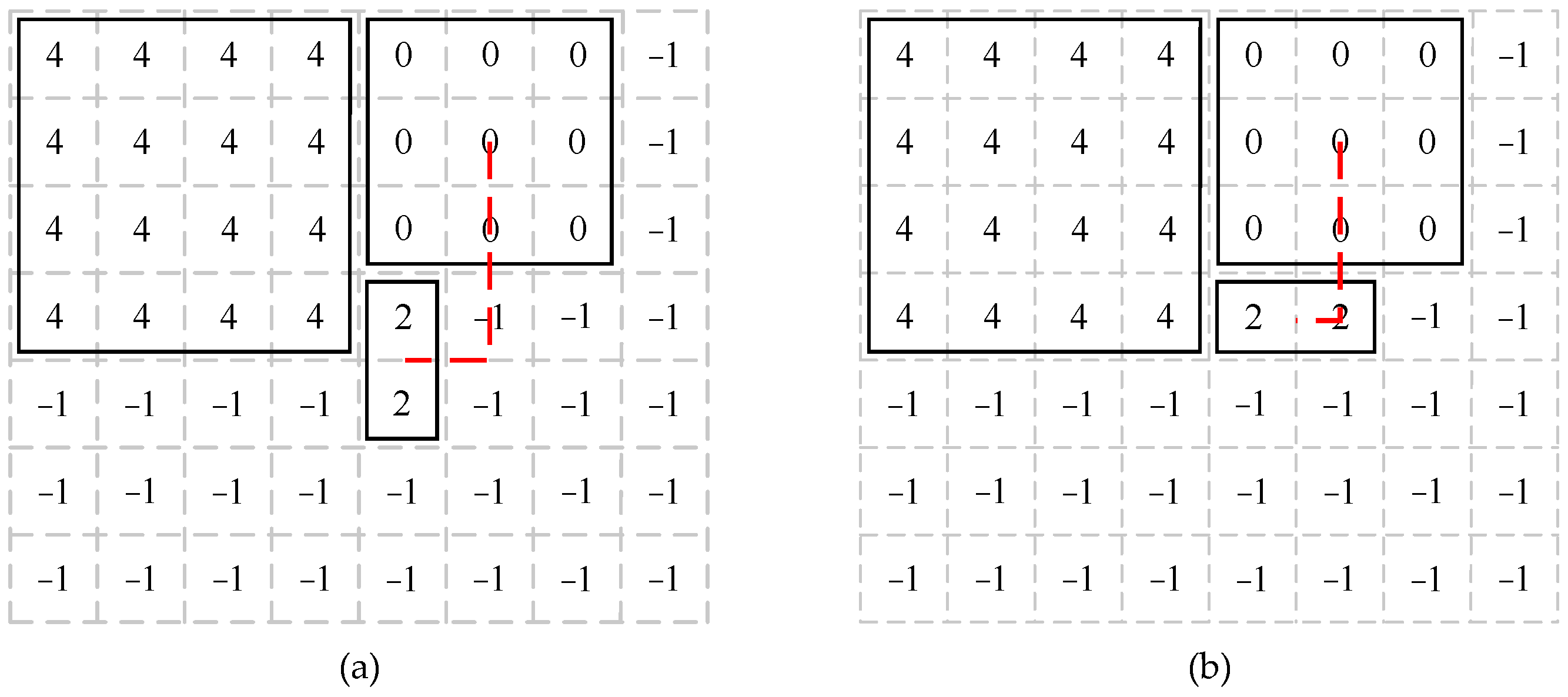
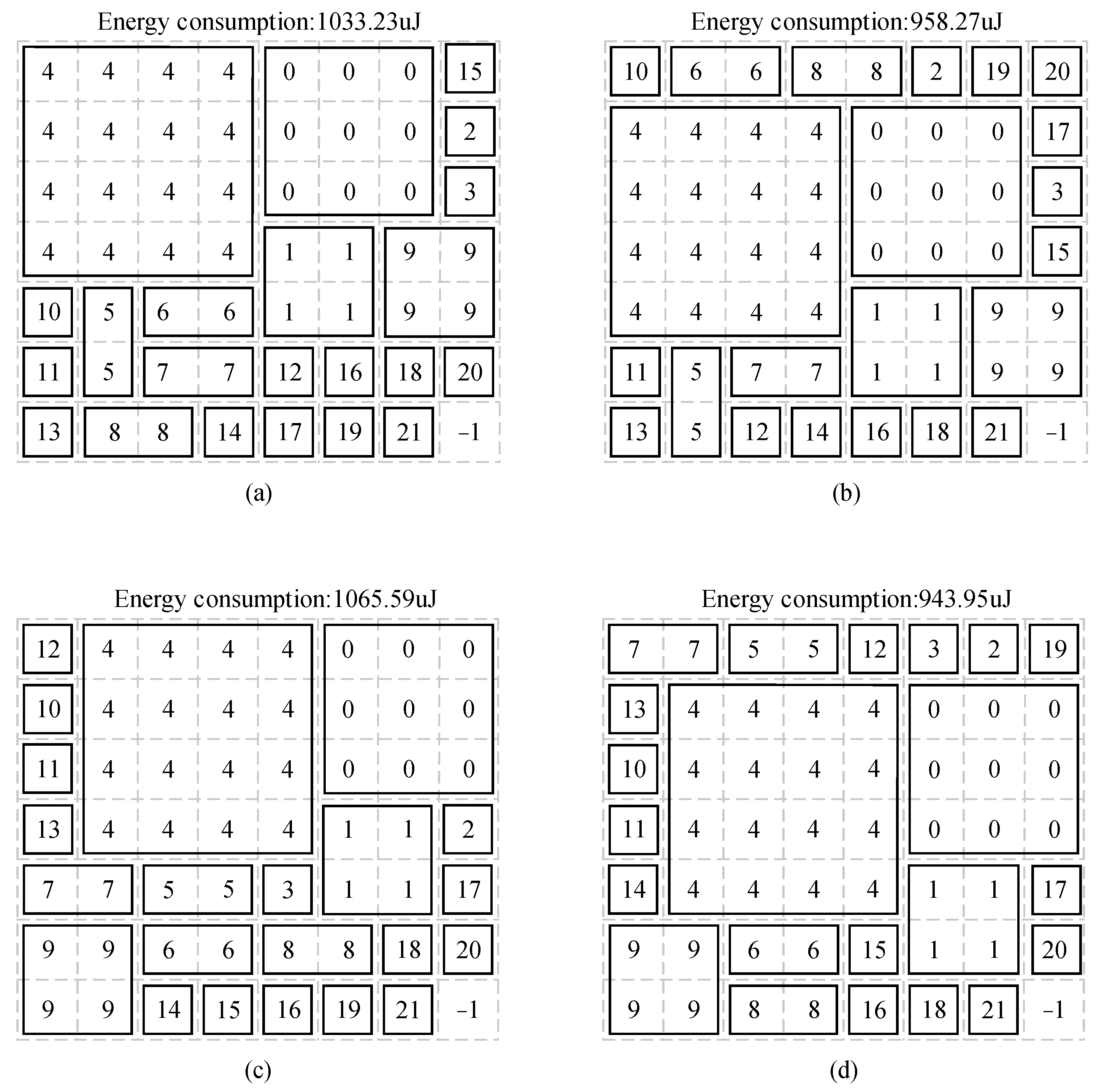
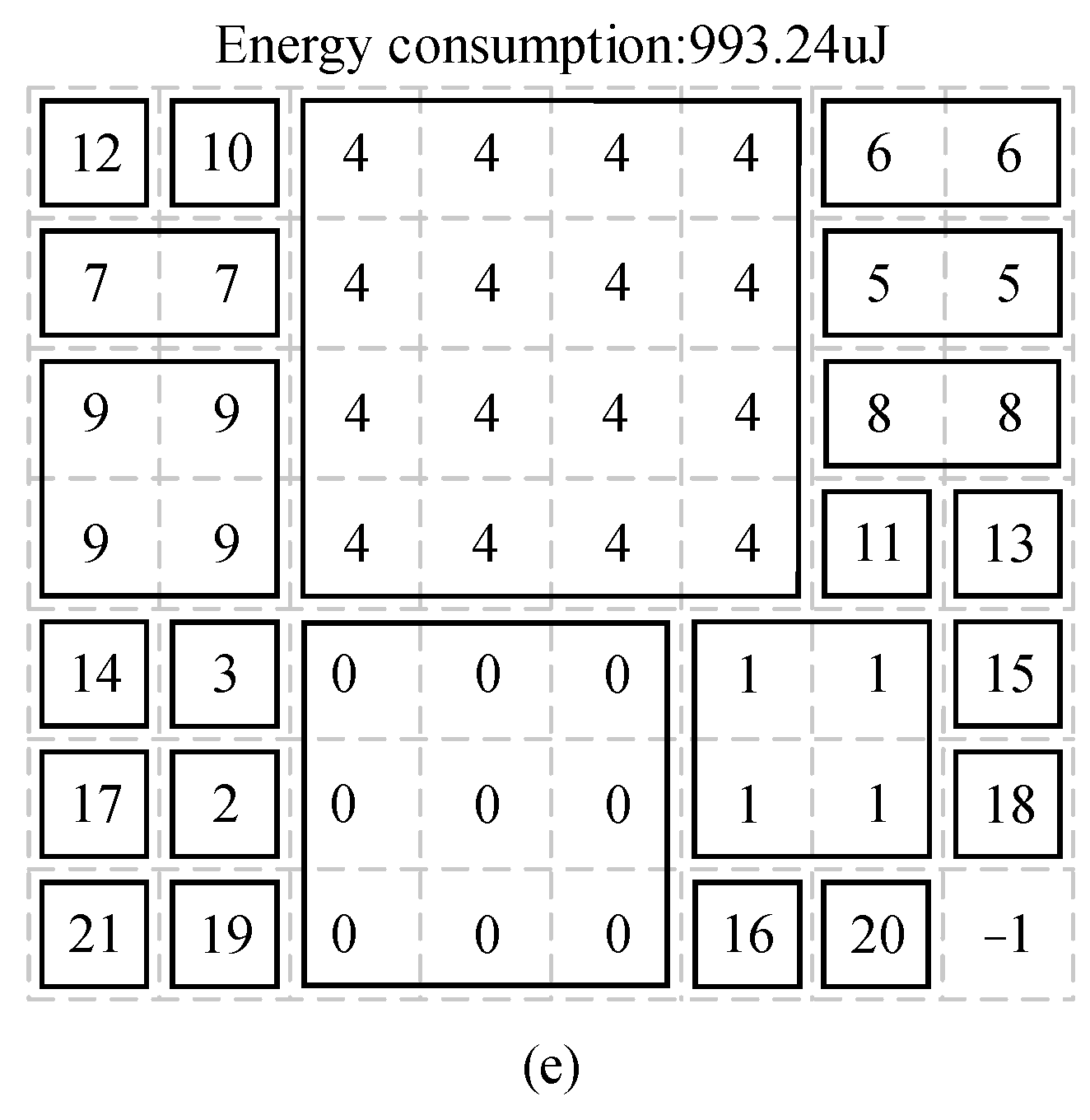

| Number | Chiplet Name | Actual Size (mm2) | Theoretical Size (mm2) |
|---|---|---|---|
| 0 | Memory | 6.9 × 6.8 | 9 × 9 |
| 1 | AD | 4.7 × 4.6 | 6 × 6 |
| 2 | D51 | 2.3 × 2.3 | 3 × 3 |
| 3 | D52 | 2.3 × 2.3 | 3 × 3 |
| 4 | FPGA | 10.6 × 10.0 | 12 × 12 |
| 5 | D10 | 4.8 × 1.7 | 6 × 3 |
| 6 | D11 | 4.8 × 1.7 | 6 × 3 |
| 7 | D19 | 4.8 × 1.7 | 6 × 3 |
| 8 | D18 | 4.8 × 1.7 | 6 × 3 |
| 9 | DA | 4.9 × 4.9 | 6 × 6 |
| 10 | D8 | 1.9 × 1.7 | 3 × 3 |
| 11 | D9 | 1.9 × 1.7 | 3 × 3 |
| 12 | D12 | 1.9 × 1.7 | 3 × 3 |
| 13 | D13 | 1.9 × 1.7 | 3 × 3 |
| 14 | D16 | 1.9 × 1.7 | 3 × 3 |
| 15 | D17 | 1.9 × 1.7 | 3 × 3 |
| 16 | D20 | 1.9 × 1.7 | 3 × 3 |
| 17 | D21 | 1.9 × 1.7 | 3 × 3 |
| 18 | D27 | 1.9 × 1.7 | 3 × 3 |
| 19 | D26 | 1.9 × 1.7 | 3 × 3 |
| 20 | D25 | 1.9 × 1.7 | 3 × 3 |
| 21 | D24 | 1.9 × 1.7 | 3 × 3 |
| Priority | Number | Chiplet Name | Communication Volume (Mbit/s) |
|---|---|---|---|
| 1 | 4 | FPGA | 900 |
| 2 | 0 | Memory | 625 |
| 3 | 1 | AD/DA | 325 |
| 4 | 2 | D5_1 | 133 |
| 3 | D5_2 | 133 | |
| 5 | 5 | D10 | 80 |
| 6 | D11 | 80 | |
| 7 | D19 | 80 | |
| 8 | D18 | 80 | |
| 6 | 9 | D4 | 15 |
| 7 | 10 | D8 | 10 |
| 11 | D9 | 10 | |
| 12 | D12 | 10 | |
| 13 | D13 | 10 | |
| 14 | D16 | 10 | |
| 15 | D17 | 10 | |
| 16 | D20 | 10 | |
| 17 | D21 | 10 | |
| 18 | D27 | 10 | |
| 19 | D26 | 10 | |
| 20 | D25 | 10 | |
| 21 | D24 | 10 |
Publisher’s Note: MDPI stays neutral with regard to jurisdictional claims in published maps and institutional affiliations. |
© 2022 by the authors. Licensee MDPI, Basel, Switzerland. This article is an open access article distributed under the terms and conditions of the Creative Commons Attribution (CC BY) license (https://creativecommons.org/licenses/by/4.0/).
Share and Cite
Sun, H.; Peng, X.; Cang, D.; Zhao, J.; Liu, Y. New Heuristic Algorithm for Low Energy Mapping for 2.5-D Integration. Electronics 2022, 11, 1817. https://doi.org/10.3390/electronics11121817
Sun H, Peng X, Cang D, Zhao J, Liu Y. New Heuristic Algorithm for Low Energy Mapping for 2.5-D Integration. Electronics. 2022; 11(12):1817. https://doi.org/10.3390/electronics11121817
Chicago/Turabian StyleSun, Haiyan, Xinwei Peng, Dongqing Cang, Jicong Zhao, and Yanhua Liu. 2022. "New Heuristic Algorithm for Low Energy Mapping for 2.5-D Integration" Electronics 11, no. 12: 1817. https://doi.org/10.3390/electronics11121817





